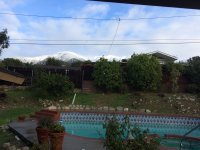- Location
- Chapel Hill, NC
- Occupation
- Retired Electrical Contractor
This is going to be a costly change as now the single #8 running around the contour of the pool 18-24" away 4-6 " below subgrade will only apply to above ground pools.
NFPA 70®-2020 and Proposed 2023 Editions National Electrical Code® TIA Log No.: 1661 Reference: 680.26(B)(2)(b) Comment Closing Date: July 7, 2022 Submitter: Thomas Kilpatrick, Kilpatrick Law Group, PLLC www.nfpa.org/70 1. Revise paragraph 680.26(B)(2)(b) to read as follows: 680.26 Equipotential Bonding. (A) Performance. … (B) Bonded Parts. … (1) Conductive Pool Shells. … (2) Perimeter Surfaces. … (a) Structural Reinforcing Steel. … (b) Copper Ring. … (1) … (2) … (3) … (4) … (5) … This method shall only be permitted for aboveground pools. (c) Copper Grid. … (3) Metallic Components. … Substantiation: Article 680.26B is dangerously insufficient with regards to in-ground pools. The deficiency is that a single bonding wire does not offer adequate protection against electric shocks. Two new reports show that a bonding grid, as prescribed in Art. 680.26B(2)(a) and/or 680.26(B)(2)(c), that is connected to the swimming pool deck and other conducting objects in the pool area -- rather than a single wire -- provides the suitable level of protection against these shocks. Emergency Nature: The proposed TIA intends to offer to the public a benefit that would lessen a recognized (known) hazard or ameliorate a continuing dangerous condition or situation. The proposed TIA intends to correct a circumstance in which the revised NFPA Standard has resulted in an adverse impact on a product or method that was inadvertently overlooked in the total revision process or was without adequate technical (safety) justification of the action. Two new reports by the Electric Power Research Institute (“EPRI”) with measurements being taken and/or verified by Duke Energy. These are examples of two residential pools in North Carolina that were built with adherence to the NEC, in compliance with Article 680.26(B)(2)(b). However, after completion, painful shock voltages existed between the water and the pool deck, the bonded ladder and the pool deck, the bonded handrail and the pool deck. This clearly demonstrates that the pool deck cannot be brought to the equipotential of the other bonded surfaces by using the single copper bonding wire specified in (B)(2)(b). Anyone contacting one of those bonded parts and the pool deck simultaneously experienced shocking to the level of physical pain and the generation of tremendous fear. Brand new pools were hazardous and unusable, so the experts from EPRI were called in to determine the problem and the solution. At both of these pools, the homeowners were experiencing perceptible burning sensations between the pool water and the pool decks around the pool. At these two pools, EPRI measured voltage differences between the water and decks in the range of 2 Vac to 10 Vac. Moreover, these voltage levels can be demonstrated to increase to and decrease over the course of a day or a week thereby violating the equipotential objects and surfaces intent of NEC Article 680.26. Of most concern is the voltage differences at these two pools that are (B)(2)(b) compliant, can be demonstrated to go to full line voltage during fault conditions and the shock currents under those conditions exceed known human fibrillation levels. In each of the homeowner’s situations, the single wire prescribed in 680.26(B)(2)(b) was installed, but failed to provide adequate protection. Therefore, brand new concrete pool decks had to be destroyed and removed and copper equipotential bonding grids installed per Art. 680.26 (B)(2)(c), and then new pool decks were installed. After the installation of the bonding grid, the measured voltage differences between the bonded parts and the deck are insignificant and the homeowners have not experienced any further electrical shock and can safely use their pools. EPRI’s testing proves the situation as hazardous with the single wire, yet completely safe with a bonding grid. Anyone may submit a comment by the closing date indicated above. Please identify the TIA number and forward to the Secretary, Standards Council.


